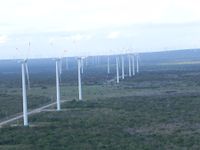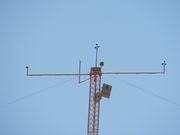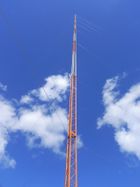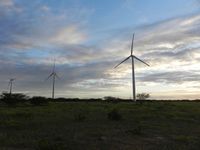Difference between revisions of "Energy Auctions in Brazil"
***** (***** | *****) |
***** (***** | *****) |
||
| (11 intermediate revisions by the same user not shown) | |||
| Line 21: | Line 21: | ||
The monitoring system for anemometric measurement (port. ''Acompanhamento de Medições Anemomêtricas ''- AMA) was created in 2010 in order to establish a database for wind measurement data. It increases the knowledge about the wind energy potential in different Brazilian regions, enabling further studies and strengthening the participation of wind energy in the Brazilian energy mix. AMA´s data comes from anemometric and climatic towers whose installation is obligatory for wind energy ventures that won a lot in an energy auction. In 2011, nearly 70 towers initiated data transmission and 370 are expected to enter into operation until the end of 2015<ref name="EPE">EPE: Notícias. http://www.epe.gov.br/Paginas/default.aspx (Retrieved on 5-8-2015)</ref><ref name="EPE2">EPE: Destaques de Geração de Energia. http://www.epe.gov.br/geracao/Paginas/default.aspx (Retrieved on 5-8-2015) </ref>.<br/> | The monitoring system for anemometric measurement (port. ''Acompanhamento de Medições Anemomêtricas ''- AMA) was created in 2010 in order to establish a database for wind measurement data. It increases the knowledge about the wind energy potential in different Brazilian regions, enabling further studies and strengthening the participation of wind energy in the Brazilian energy mix. AMA´s data comes from anemometric and climatic towers whose installation is obligatory for wind energy ventures that won a lot in an energy auction. In 2011, nearly 70 towers initiated data transmission and 370 are expected to enter into operation until the end of 2015<ref name="EPE">EPE: Notícias. http://www.epe.gov.br/Paginas/default.aspx (Retrieved on 5-8-2015)</ref><ref name="EPE2">EPE: Destaques de Geração de Energia. http://www.epe.gov.br/geracao/Paginas/default.aspx (Retrieved on 5-8-2015) </ref>.<br/> | ||
| + | |||
| + | <br/> | ||
| + | |||
| + | Infosheet: Cooperation in the area of wind energy - [[:File:Cooperação na área de Energia Eólica.pdf|Cooperação na área de Energia Eólica (2015)]] | ||
| + | |||
| + | A better knowledge about wind regimes in Brazil is crucial for the promotion of this energy source as well as improved energy planning. GIZ supported EPE by the design and administration of the monitoring system for anemometric measurement (port. Acompanhamento de Medições Anemomêtricas - AMA) and the development of products concerning the AMA data bases, p. ex. a Brazilian Wind Index. | ||
<br/> | <br/> | ||
| Line 65: | Line 71: | ||
<br/> | <br/> | ||
| + | |||
| + | |||
== Application of wind energy data<br/> == | == Application of wind energy data<br/> == | ||
| Line 77: | Line 85: | ||
The Brazilian Wind Atlas was developed in 2001 to map the Brazilian wind energy potential. This study develops a methodology to renew the atlas, considering that wind measurement tools, mathematical and terrain models, satellite data improved significantly during the last decade and new data generated in the framework of AMA that could now be included into the atlas. | The Brazilian Wind Atlas was developed in 2001 to map the Brazilian wind energy potential. This study develops a methodology to renew the atlas, considering that wind measurement tools, mathematical and terrain models, satellite data improved significantly during the last decade and new data generated in the framework of AMA that could now be included into the atlas. | ||
| − | + | ||
<br/> | <br/> | ||
| + | Influence of climatic aspects in wind and solar sources -[[:File:Descrição_e_caraterização_dos_fenômenos_atmosféricos_mais_frequentes_no_território_brasileiro.pdf|Descrição e caraterização dos fenômenos atmosféricos mais frequentes no território brasileiro (2015)]] | ||
| + | |||
| + | Understanding the influence of global and mesoscale climatic aspects on energy sources, allows a better known of the behavior of these energy sources as well the correlation between them. This study brings out the influence of climatic aspects in the behavior of the water, sun and wind. | ||
| + | |||
| + | <br/> | ||
| + | </div> | ||
[[Energy Auctions in Brazil#toc|►Go To Top]]<br/> | [[Energy Auctions in Brazil#toc|►Go To Top]]<br/> | ||
<br/> | <br/> | ||
| + | |||
= Auctions for isolated systems<br/> = | = Auctions for isolated systems<br/> = | ||
| Line 92: | Line 107: | ||
== Support for off grid/ mini grid system auctions == | == Support for off grid/ mini grid system auctions == | ||
| − | Integration potential of photovoltaic energy in isolated grids with diesel generators - [[:File:Potencial de integração fotovoltaica em redes de geração diesel. Pau Farrés Antúnez.pdf|Potencial de integração de energia fotovoltaica em redes isoladas com geradores a diesel (2013)]] | + | [[File:Generator.JPG|border|left|120px|Polluting diesel generator|alt=Polluting diesel generator]]Integration potential of photovoltaic energy in isolated grids with diesel generators - [[:File:Potencial de integração fotovoltaica em redes de geração diesel. Pau Farrés Antúnez.pdf|Potencial de integração de energia fotovoltaica em redes isoladas com geradores a diesel (2013)]] |
The application of photovoltaic energy in isolated systems is viable – it’s the conclusion of this feasibility study. The author compares two different scenarios with different generation system sizes and fuel costs and concludes that the introduction of hybrid photovoltaic-diesel systems in remote areas is overall beneficial. The simulation was carried out through software HOMER, which is specially designed for simulations of hybrid generation systems. | The application of photovoltaic energy in isolated systems is viable – it’s the conclusion of this feasibility study. The author compares two different scenarios with different generation system sizes and fuel costs and concludes that the introduction of hybrid photovoltaic-diesel systems in remote areas is overall beneficial. The simulation was carried out through software HOMER, which is specially designed for simulations of hybrid generation systems. | ||
| Line 106: | Line 121: | ||
<br/> | <br/> | ||
| − | Energy simulations of isolated systems - [[:File:Simulações Energéticas dos Sistemas Isolados.pdf|Simulações energéticas dos sistemas isolados (2014)]] | + | [[File:PV system in Sobrado Community- Amazonas, Brazil.JPG|border|right|140px|PV system in the Community Sobrado - Amazonas, Brazil|alt=PV system in Sobrado Community- Amazonas, Brazil]]Energy simulations of isolated systems - [[:File:Simulações Energéticas dos Sistemas Isolados.pdf|Simulações energéticas dos sistemas isolados (2014)]] |
The aim of the energy simulations described in this study was to evaluate the feasibility of renewable energy based generation systems in remote areas. It contains energy simulations of four locations in Acre-state, Amazonia, and a generic case study about the expansion of renewable energies in isolated systems. The author argues that hybrid energy systems with combined diesel generators, photovoltaic systems and batteries serve to cover the energy demand more economically than common diesel generators. | The aim of the energy simulations described in this study was to evaluate the feasibility of renewable energy based generation systems in remote areas. It contains energy simulations of four locations in Acre-state, Amazonia, and a generic case study about the expansion of renewable energies in isolated systems. The author argues that hybrid energy systems with combined diesel generators, photovoltaic systems and batteries serve to cover the energy demand more economically than common diesel generators. | ||
| Line 128: | Line 143: | ||
<br/> | <br/> | ||
| − | <span style="font-size: 21.7600002288818px; line-height: 30.4640007019043px; background-color: initial;">Photovoltaic auctions</span><br/> | + | = <span style="font-size: 21.7600002288818px; line-height: 30.4640007019043px; background-color: initial;">Photovoltaic auctions</span><br/> = |
In 2013 photovoltaic project could participate in regular energy auctions for the first time, but the participating projects could not compete with cheaper technologies like wind power. In October 2014 the first specific PV auctions was realized. 31 PV projects with a total installed capacity of 889 MWp signed Power Purchase Agreement (PPA) with duration of 20 years. Additionally, the Brazilian development bank BNDES launched a credit line with favorable conditions for the PV projects. | In 2013 photovoltaic project could participate in regular energy auctions for the first time, but the participating projects could not compete with cheaper technologies like wind power. In October 2014 the first specific PV auctions was realized. 31 PV projects with a total installed capacity of 889 MWp signed Power Purchase Agreement (PPA) with duration of 20 years. Additionally, the Brazilian development bank BNDES launched a credit line with favorable conditions for the PV projects. | ||
| Line 134: | Line 149: | ||
<br/> | <br/> | ||
| − | PV auctions as new element of the Brazilian energy policy - [[:File:Infoblatt Photovoltaik-Auktionen - Neues Element der brasilianischen Energiepolitik.pdf|Photovoltaik-Auktionen – Neues Element der brasilianischen Energiepolitik]] (2015) | + | [[File:Comercial PV plant in Santa Tubarão (Brazil).jpg|border|left|180px|Comercial PV plant in Santa Tubarão (Brazil)|alt=Comercial PV plant in Santa Tubarão (Brazil)]]Infosheet: PV auctions as new element of the Brazilian energy policy - [[:File:Infoblatt Photovoltaik-Auktionen - Neues Element der brasilianischen Energiepolitik.pdf|Photovoltaik-Auktionen – Neues Element der brasilianischen Energiepolitik]] (2015) |
The Brazilian government aims to support the development of PV in Brazil by the introduction of specific PV auctions, following the same approach like it was realized before with wind power, which led to the successful enlargement of the wind power industry and installed wind capacity in Brazil. GIZ supported the process by promoting know-how-transfer, institutional exchange and dissemination of market opportunities in the PV business. | The Brazilian government aims to support the development of PV in Brazil by the introduction of specific PV auctions, following the same approach like it was realized before with wind power, which led to the successful enlargement of the wind power industry and installed wind capacity in Brazil. GIZ supported the process by promoting know-how-transfer, institutional exchange and dissemination of market opportunities in the PV business. | ||
| + | |||
| + | <br/> | ||
| + | |||
| + | Article: PV Auctions – New element of Brazilian energy policies - [[:File:Photovoltaik-Auktionen- neues Element der brasilianischen Energiepolitik.pdf|Photovoltaik-Auktionen – Neues Element der brasilianischen Energiepolitik (2015)]] | ||
| + | |||
| + | This article gives more information about the Brazilian energy auctions model, the results of the first PV auction, financial incentives for the projects as well as an outlook for further auctions in 2015. The first auction showed that there is a huge interest by investors to enter the Brazilian PV market. | ||
<br/> | <br/> | ||
Latest revision as of 17:58, 16 November 2015
Introduction
Brazil has an energy auction system to expand transmission lines and buy electricity generated by new power plants. The auction system should guarantee that energy services follow the compliance of pre-defined quality standards combined with the cheapest possible price. In this system, every technically qualified company can participate at auctions offering its services. This stimulates the opening of the market and the increase of competition. All these factors together promote the reduction of electricity generation costs. Deutsche Gesellschaft für Internationale Zusammenarbeit (GIZ) GmbH[1] supports its partner, the Brazilian Energy Planning Authority EPE (port. Empresa de Pesquisa Energética), at enhancing the conditions for the participation of renewable energies at energy auctions. This includes the improvement of regulations, long-term monitoring of potentials to adequate auctions according energy demands and preparing auctions for the entry of innovative energy sources.
Summary of energy auctions felled from renewable energy sources - Sumário dos leilões de energia provenientes de fontes renováveis (2015)
This spreadsheet gives an overview about the results of the energy auctions with participation of renewable energies from 2007 to 2015. It offers information about how many projects were registered, qualified and finally contracted, what was their potential and what was the price achieved in the auction.
Wind energy auctions
The first exclusive wind energy auction was realized in 2009. 71 wind energy projects with a potential of two Gigawatt (GW) were contracted. Since then, wind energy turned competitive and could subsequently dispute with other energy sources in the auctions. Till date, there were 14 auctions with a participation of wind energy, totalizing 561 contracted wind energy projects with a capacity of 14 GW till 2019 and an average price of aproximately R$ 125,00/MWh[2][3].
Increasing the knowledge of wind potential
The monitoring system for anemometric measurement (port. Acompanhamento de Medições Anemomêtricas - AMA) was created in 2010 in order to establish a database for wind measurement data. It increases the knowledge about the wind energy potential in different Brazilian regions, enabling further studies and strengthening the participation of wind energy in the Brazilian energy mix. AMA´s data comes from anemometric and climatic towers whose installation is obligatory for wind energy ventures that won a lot in an energy auction. In 2011, nearly 70 towers initiated data transmission and 370 are expected to enter into operation until the end of 2015[4][5].
Infosheet: Cooperation in the area of wind energy - Cooperação na área de Energia Eólica (2015)
A better knowledge about wind regimes in Brazil is crucial for the promotion of this energy source as well as improved energy planning. GIZ supported EPE by the design and administration of the monitoring system for anemometric measurement (port. Acompanhamento de Medições Anemomêtricas - AMA) and the development of products concerning the AMA data bases, p. ex. a Brazilian Wind Index.
Stochastic modeling of wind power generation for energy studies - Modelagem Estocástica da Geração Eólica para Estudos Energéticos (2010)
Anticipating the creation of the AMA system, the project “Stochastic modelling of wind power generation for energy studies” aims on the explorative analysis of wind energy data. In this study, wind data obtained by three power plants in Ceará-state from 1999 to 2009 and from a synthetic series built for the period 1976 – 2008 were evaluated. The aim was to obtain a wind statistical modelling to perfume studies, such as correlation of wind and water in electricity generation.
Classification methodology of weather stations for wind potential studies - Coleta de dados de vento estrategicamente distribuídos pelo território nacional (2010)
In order to establish a long term wind measurement system for wind energy studies, 47 Brazilian meteorological stations were chosen to provide necessary data of wind. This study gives information about the selection process of the stations according the therefore elaborated methodology and shows their distribution on the national territory.
Management of the long term wind energy database - Gerenciamento de banco de dados de vento de longo prazo (2011)
The implementation of a wind energy database needed to be prepared carefully. In this study, formal criteria to maintain this database are defined, such as: type of data records, classification, filtering and consolidation of data.
Consistency and exploration analysis of meteorological data - Análise de Consistência e Exploratória de Dados Meteorológicos (2012)
After the introduction of AMA as computational tool for the elaboration of a wind energy database, it was necessary to supply it with data consistent and reliable quality, which requires a prior analysis of the consistency of measurements before forming part of the bank. This study shows how to ensure these data checking physical limits, others measurements, temporal behavior etc.
Technical note about installation instructions and reporting of maintenance of the AMA system anemometric stations –
This technical note gives specifications on how to elaborate the report about the installation and maintenance of the wind measurement stations of the AMA system. The installation report suggests include information about the localization of measurement stations, description of the towers, installed measurement instruments as well as verification of their functioning and the certificates for calibration of anemometers.
Technical note about instructions for wind speed and climatologic measurements in wind farms -
Since 2011, anemometric measurement is legally obligatory for wind energy ventures that obtain auctioned capacities[6] in order to generate and transmit data of the AMA system. To structure this process, this technical note from EPE gives specifications on characteristics of the measurement stations, equipment and how to register the stations. It also defines the format for transmitted data.
Application of wind energy data
Development of a Wind Index Concept for Brazil (2013)
Wind indexes can compare the wind behavior of a region with the performance of turbines or wind farms. In this study, it shows a methodology to group regions with similar wind behavior and then compare the wind conditions of locals inside the area with a reference value of this area, be it monthly, yearly etc. These indexes are also important to identify long-term correlations among wind supply and water level in the river basins, which, in a country like Brazil with a high percentage of hydro generation, can improve energy planning significantly.
The Brazilian Wind Atlas was developed in 2001 to map the Brazilian wind energy potential. This study develops a methodology to renew the atlas, considering that wind measurement tools, mathematical and terrain models, satellite data improved significantly during the last decade and new data generated in the framework of AMA that could now be included into the atlas.
Influence of climatic aspects in wind and solar sources -Descrição e caraterização dos fenômenos atmosféricos mais frequentes no território brasileiro (2015)
Understanding the influence of global and mesoscale climatic aspects on energy sources, allows a better known of the behavior of these energy sources as well the correlation between them. This study brings out the influence of climatic aspects in the behavior of the water, sun and wind.
Auctions for isolated systems
Part of the Brazilian population still lives in areas where the national electric grid isn’t available. In such regions, electricity must be supplied through small decentralized systems. In this sense, Brazilian legislation imposes that distribution companies acquire electric power via energy auctions specially designed to meet these needs.
Support for off grid/ mini grid system auctions
Integration potential of photovoltaic energy in isolated grids with diesel generators - Potencial de integração de energia fotovoltaica em redes isoladas com geradores a diesel (2013)
The application of photovoltaic energy in isolated systems is viable – it’s the conclusion of this feasibility study. The author compares two different scenarios with different generation system sizes and fuel costs and concludes that the introduction of hybrid photovoltaic-diesel systems in remote areas is overall beneficial. The simulation was carried out through software HOMER, which is specially designed for simulations of hybrid generation systems.
Planning instructions for Energy Supply of Isolated Systems and presentation of Reference Projects – Instruções para o encaminhamento do atendimento aos sistemas isolados e apresentação de Projetos de Referência (2014)
In order to plan the long term energy supply of Isolated Systems, EPE published instructions describing the elaboration of the mandatory planning report regarding operation and expansion of both energy production and demand in these areas. This information, submitted by the local electricity providers, supports the preservation and future improvement of energy supply in remote areas with isolated systems. The planning process is divided in three steps: definition of consumer market and load, analysis of electricity supply and verification of energy balance and, finally, presentation of Reference Project to supply the unmet demand.
EPE publishes instructions for the planning of the attendence of consumer markets in isolated systems - EPE publica instruções para o planejamento de mercados de consumidores dos sistemas isolados (2014)
Energy simulations of isolated systems - Simulações energéticas dos sistemas isolados (2014)
The aim of the energy simulations described in this study was to evaluate the feasibility of renewable energy based generation systems in remote areas. It contains energy simulations of four locations in Acre-state, Amazonia, and a generic case study about the expansion of renewable energies in isolated systems. The author argues that hybrid energy systems with combined diesel generators, photovoltaic systems and batteries serve to cover the energy demand more economically than common diesel generators.
Analysis guide for projects in remote areas - Elaboração do Guia para Análise de Projetos para Regiões Remotas (2014)
The last step of the planning process for energy supply of isolated systems is the presentation of the reference project. EPE is responsible for the analysis and approval of the reference project elaborated by the energy providers. This guide works as a tool to facilitate the evaluation process done by EPEs staff, providing excel sheets about instructions, analysis guide, reference about investment costs and proposed timetable.
Instructions for the elaboration and presentation of alternative projects of energy supply - Instruções para Elaboração e Apresentação de Projetos Alternativos aos Projetos de Referência (2014)
The reference project describes the solution for the energy supply in the isolated system and is proposed by the local energy provider. This project serves as a standard at the energy auction carried out to supply electricity in isolated systems. However, during the bid process, entrepreneurs may submit alternative projects seeking to replace the Reference Project and compete in the auction. Nevertheless, the alternative project needs to be qualified by EPE. This study supported the preparation of instructions for the elaboration of alternative projects.
Photovoltaic auctions
In 2013 photovoltaic project could participate in regular energy auctions for the first time, but the participating projects could not compete with cheaper technologies like wind power. In October 2014 the first specific PV auctions was realized. 31 PV projects with a total installed capacity of 889 MWp signed Power Purchase Agreement (PPA) with duration of 20 years. Additionally, the Brazilian development bank BNDES launched a credit line with favorable conditions for the PV projects.
Infosheet: PV auctions as new element of the Brazilian energy policy - Photovoltaik-Auktionen – Neues Element der brasilianischen Energiepolitik (2015)
The Brazilian government aims to support the development of PV in Brazil by the introduction of specific PV auctions, following the same approach like it was realized before with wind power, which led to the successful enlargement of the wind power industry and installed wind capacity in Brazil. GIZ supported the process by promoting know-how-transfer, institutional exchange and dissemination of market opportunities in the PV business.
Article: PV Auctions – New element of Brazilian energy policies - Photovoltaik-Auktionen – Neues Element der brasilianischen Energiepolitik (2015)
This article gives more information about the Brazilian energy auctions model, the results of the first PV auction, financial incentives for the projects as well as an outlook for further auctions in 2015. The first auction showed that there is a huge interest by investors to enter the Brazilian PV market.
Preparation of PV auctions
Registration instructions for photovoltaic and concentrating solar power systems for new energy auctions - Instruções de cadastramento de sistemas fotovoltaicos e heliotérmicos em leilões de energia nova (2013)
In 2013, the Brazilian Ministry of Mines and Energy authorized, for the first time, the participation of bids from photovoltaic and concentrating solar power (CSP) projects in an auction contracting new energy lots[7] Seeking to facilitate the technical qualification executed by EPE, the registration instructions for PV and CSP systems for energy auctions help entrepreneurs to specify required technical and administrative details of the participating projects. This report supported the elaboration of the instructions published by EPE.
The improved registration instructions as outcomes of the improvement process can be found on EPE´s website, where there are also instructions for other energy sources:
EPE registration instructions - Instruções para cadastramento (2014)
Strategic PV research and development project in Brazil - Strategisches Forschungs- und Entwicklungsprojekt Photovoltaik in Brasilien (2014)
Primeiro programa de incentivo à energia fotovoltaica (2014)
To amplify and diversify the application of financial resources of the ANEEL’s Research & Development Program for renewable energy projects, ANEEL created the Strategical R&D Photovoltaic Project. Since 2011,GIZ support ANEEL in developing a tender that encouraged energy companies to apply their R&D resources on commercial solar generation plants up to 3 MWp. Thus this measure could significantly improve spending on research and development of renewable energies in Brazil. 18 Photovoltaic projects has since been approved by ANEEL, some of them, for example the world cup solar stadiums Recife, are already realized involving huge private investment. Through the Strategical R&D Photovoltaic Project, 165.000 Euro of German spending led to 100 Mio. Euro Brazilian investment.
Dissemination of PV auctions
Framework Assessment for the Photovoltaic Business Opportunities in Brazil (2014)
Further Information
- Energypedia - Wind Energy Country Analyses Brazil
- CCEE (Câmara de Comercialização de Energia Elétrica) - Types of Energy Auctions
- ABEEólica (Associação Brasileira de Energia Eólica) – Boletim de Dados Jul. 2015
- ANEEL (Agência Nacional de Energia Elétrica) - SIGEL: Sistema de Informações Geográfica de Usinas Eólicas
- Proposta de um Modelo para Seleção de Estações Meteorológicas (2010)
References
- ↑ As a federal enterprise, the Deutsche Gesellschaft für Internationale Zusammenarbeit (GIZ) GmbH supports the federal German government in achieving its international cooperation objectives. Together, Brazil and Germany face global challenges such as preserving biodiversity and fighting climate change. The German Cooperation for Sustainable Development therefore operates primarily in two areas: Protection and sustainable management of Rain Forests as well as Renewable Energies and Energy Efficiency. Within the cooperation with the Brazilian partners GIZ provides advice on strategy development, support for developing management and cooperation structures, as well as technical expertise.
- ↑ ABEEólica 2015: Boletim de Dados. http://abeeolica.org.br/pdf/Boletim-de-Dados-ABEEolica-Julho-2015-Publico.pdf (Retrieved on 29-7-2015)
- ↑ CCEE: Biblioteca virtual. http://bit.ly/1K6EP3k (Retrieved on 29-7-2015)
- ↑ EPE: Notícias. http://www.epe.gov.br/Paginas/default.aspx (Retrieved on 5-8-2015)
- ↑ EPE: Destaques de Geração de Energia. http://www.epe.gov.br/geracao/Paginas/default.aspx (Retrieved on 5-8-2015)
- ↑ MME 2011: Portaria No.29, de 28 de Janeiro 2011. http://www.epe.gov.br/leiloes/Documents/Leil%C3%B5es%20A-3%20e%20Reserva%202011/Portaria%20MME%20n%C2%BA%2029-11.pdf (Retrieved on 29-7-2015)
- ↑ MME 2013: PORTARIA No 226, DE 5 DE JULHO DE 2013. http://www.epe.gov.br/leiloes/Documents/Leil%C3%B5es%202013/Portaria%20MME%20n%C2%BA%20226-13.pdf (Retrieved on 29-7-2015)




























